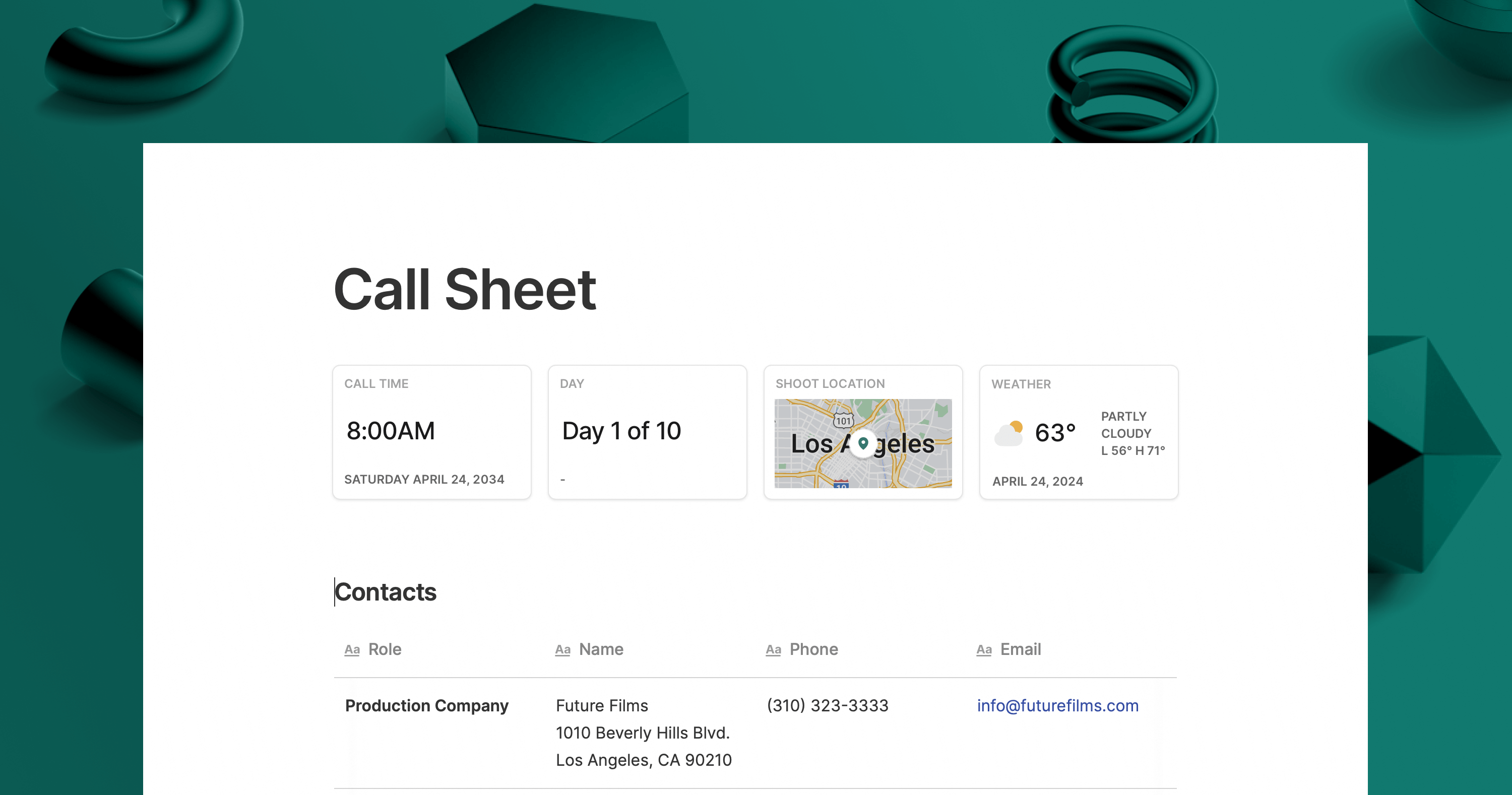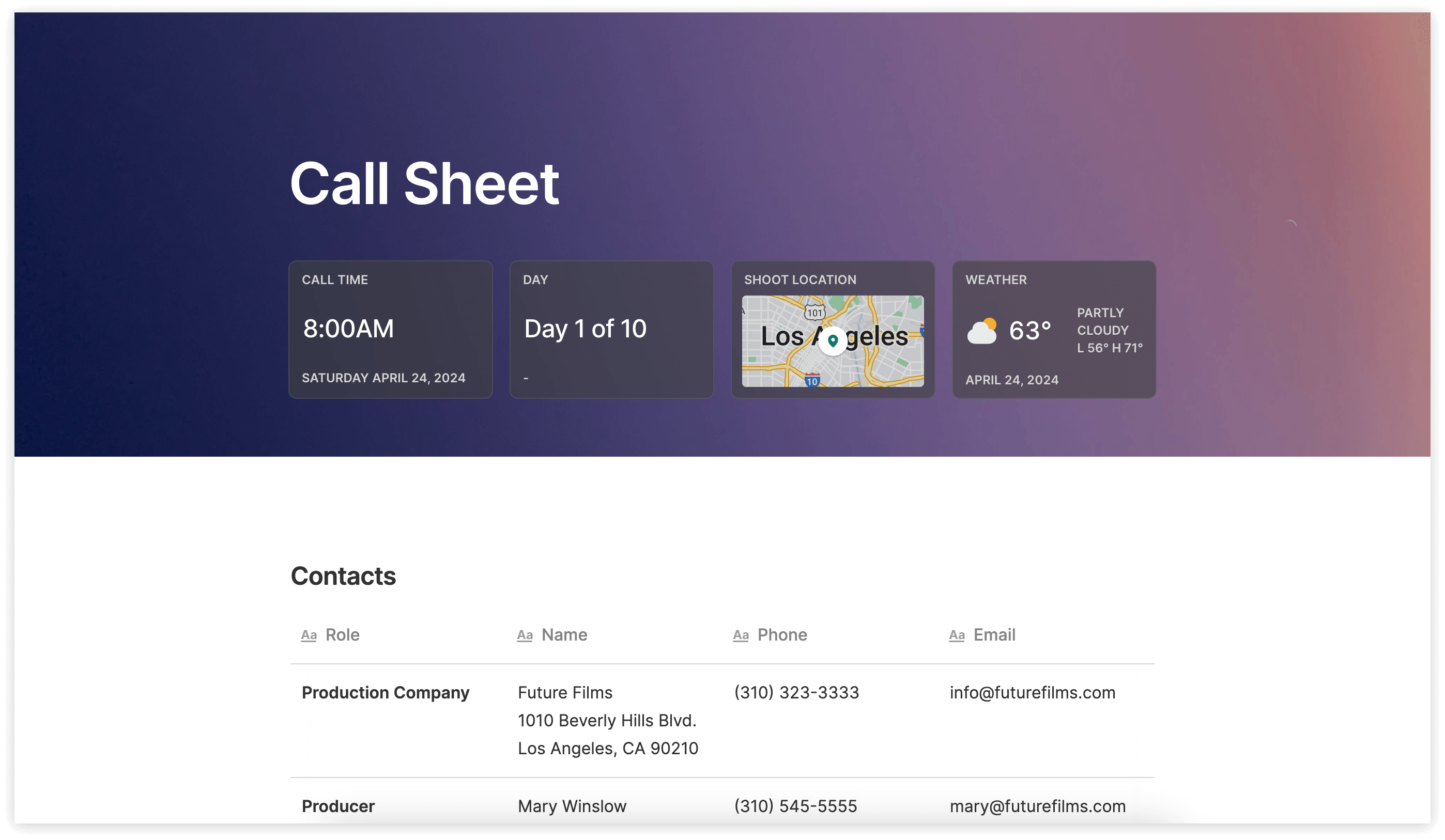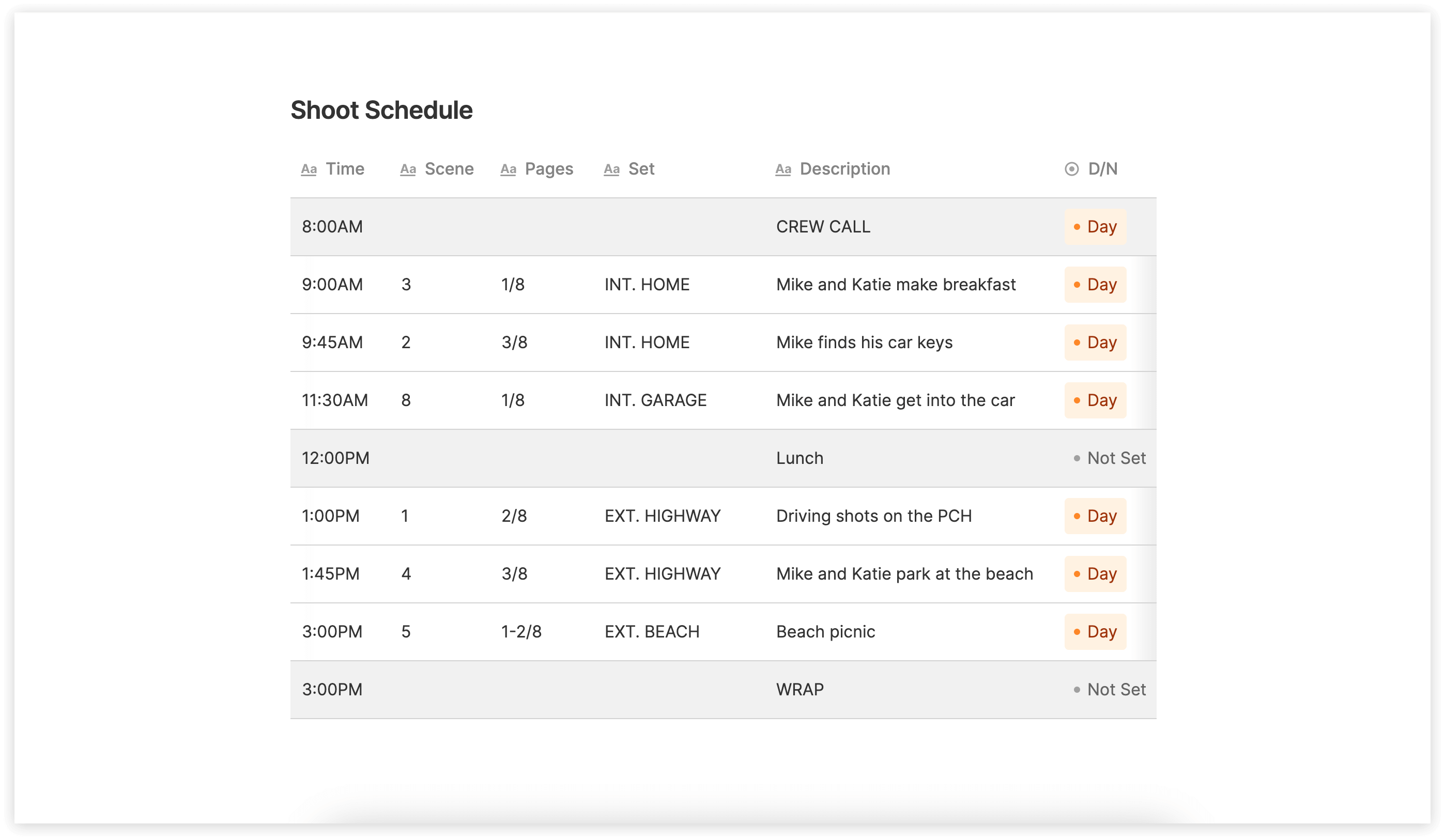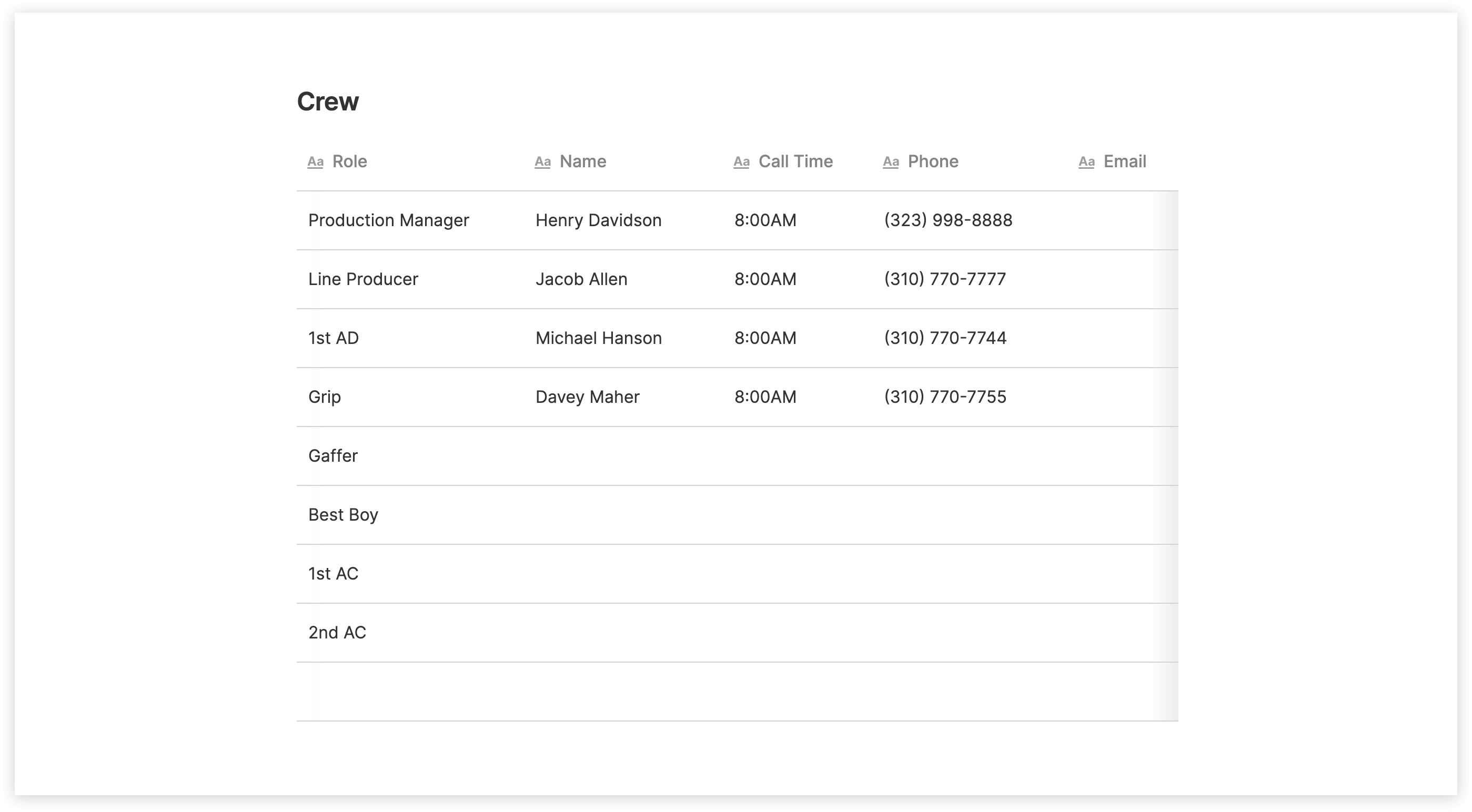Film production consists of many moving parts. Executing an idea requires various people working together to achieve a singular goal. The success of your shoot days comes down to much more than the quality of the script. It is essential to plan and communicate the logistics of your shoot to all the members of your cast and crew. To do so, filmmakers use the daily call sheet to ensure that everyone involved knows their roles and responsibilities.
This article will detail how to make a call sheet to ensure that your production goes smoothly. Before we begin, you can access a free call sheet template from Assemble below so that you can follow along and save this fully customizable, cloud-based document template for future productions.

Cloud Based Call Sheet Template
Use this call sheet template to distribute shoot day information for your next film production or photoshoot.
Get Template
And for an in-depth breakdown of how to create a call sheet, check out our video walkthrough.
What is a call sheet?
The call sheet is a document that communicates vital production information and instructions to the cast and crew. It is sent out daily by the 1st AD to all members of the production. Its primary purpose is to let everyone know where and when they will need to report to set.
What makes an excellent film call sheet template is a straightforward layout that allows the reader to understand the information easily. Having clear formatting results in your cast and crew being on the same page and laser-focused on the collective task at hand.
What is included in a call sheet?
The call sheet conveys call times (when each cast and crew member needs to arrive on set), location addresses, the shooting schedule, and the name, contact info, and additional details of each cast and crew member.
It is also a reference document, including essential information needed for everyone on a shoot, such as details about meal times, transportation, and the nearest hospital in case of emergencies.
Next, we’ll provide an overview of each section of the call sheet in greater detail so you can understand how to make a call sheet.
The Top Section

Call Times
The most critical information a call sheet must communicate is the call time. This lets the crew know when they are expected to report to the shooting location. The majority of your team will typically start work together at the same time each day. Therefore a general crew call time is listed at the top of the page.
The general crew call time should be the first thing someone sees when they open a call sheet. This time must be listed in large, bold font at the very top. Specific call times for different cast and crew are listed lower in the call sheet.
Some call sheets will also include a small section at the top listing meal times and the ‘shooting call’ (the anticipated time for the day’s first shot). Sometimes, a ‘hard out’ will also be listed to mark the definitive end of the day’s work due to location availability or union rules.
Dates
The top of the call sheet will also include a section for the shoot date. This is separated into two parts. The first part will be the standard shooting date, written as the day of the week, followed by the calendar date. An example would be “Sunday, January 1st, 2023”.
The second part is something film productions refer to as the ‘day out of days’. Since call sheets are sent out daily, they must exist within the context of the entire production schedule. So if the shooting date is the first day of a two-week production, the day out of days will be listed as “Day 1 of 14”.
Location
The location of the film shoot for the day will also be listed at the top of the call sheet. List the full address of the shooting location, parking or drop-off area, and parking instructions. It is often helpful to include a map of the location to avoid confusion.
Including safety information in case of an emergency is also a top priority. Therefore, the address of the nearest hospital must be included. This should be prominently featured in case people need to quickly locate it in an emergency.
Other locations, such as hardware stores, nearby restaurants, or bathroom arrangements (if there are none on location), can also live under this section.
With Assemble’s production management software, you can add a map widget to your document to instantly create an interactive map that will provide crew members with directions to the shooting location, nearest hospital, or other important locations.
Weather Forecast
Call sheets typically include the weather forecast, especially if you are shooting outdoors. Be sure to describe the weather conditions (sunny, cloudy, rainy) and the high and low temperatures for the day. It is also beneficial to list the exact sunrise and sunset times. This information will help the cinematographer plan the day's lighting and grip setups.
Assemble’s custom document creator also includes a weather widget that automatically adds the weather forecast for the location to your call sheet.
Production Information
General information such as the production title, the production company, and the production office contact information should also be listed near the top of the call sheet. You should also include the name and phone numbers of the top-line personnel such as the Director, Producer, Executive Producer and 1st AD.
Important Messages
Some assistant directors like to round out the top section of the call sheet with an important message to the entire crew. You can include this section as a banner separating the top section from the remaining information on a call sheet. This could be a message regarding the production’s social media tolerance policy, a particular dress code, or an encouraging phrase to set the tone for the day.
Shooting Schedule

The day’s shooting schedule references the scene and shot numbers from the shooting script or the shot list. The information is listed chronologically in the order of each setup.
The schedule is best communicated as a table listing the following information:
- Time: When the setups for the shot begin
- Scene Number: Must correspond to the script and shot list
- Pages: Scenes are broken down into eighths of a page, and the total pages shot is listed at the bottom (i.e. 3/8 pages)
- Description: Description of what the actors are doing in the scene
- Set Description: A description of the set, as well as whether the set is an interior or exterior set (written as INT or EXT).
- Day or Night: Whether the context of the scene takes place during day or night
- Cast: The cast members in the scene (listed by actor ID)
- Location: The physical location of the set
- Additional Notes: And additional notes that need to be communicated
This section should also include blocks of time for activities such as lunch, company moves, and wrap.
For more information on creating a shooting schedule, check out Assemble’s shooting schedule template.
Cast Information

The cast section includes another table containing the day’s cast members according to the shooting schedule.
This section includes information such as:
- Actor ID: A number designated to their character during the script’s breakdown
- Character Name: The name of the character in the script
- Cast Name: The name of the cast member
- Call Time: Each actor’s individual call time
- Additional Times: Pick-up times, makeup and wardrobe times, and set call times.
Crew Information

We round out the film call sheet with a table detailing every crew member, broken down by departments. Each crew member should be listed with their title, full name, and individual call time.
The production manager, line producer, and 1st AD should be listed clearly at the top of this table. The phone numbers of these crew members are necessary in case anyone needs clarification, calls in sick, or has other emergencies. Special communication instructions, such as walkie-talkie channels, will be listed here if needed.
You can also note down helpful instructions and reminders for each department in this area. Everyone in the crew may not read this section, but it keeps all the departments on the same page.
The Advance Schedule (Optional)
This is an optional preview of the following day’s work. It is precisely the same as the shooting schedule section, but created for the next shoot day. Conveying this information allows certain departments to prepare for the next day’s setups. For example, a specific prop or piece of equipment might be required, and the advance schedule allows the crew to mentally and physically prepare.
Call Sheet Etiquette
It is best practice to include all the sections listed above on one single page to make the information easy to read.
Never leave your crew waiting for a call sheet long after the day is wrapped. Always prepare the following day’s call sheet in advance, making adjustments when necessary. The appropriate time to send out the next day’s call sheet to the cast and crew is immediately after the ‘martini,’ which is the final shot of the day.
How to make a call sheet the easy way
Assemble’s cloud-based document builder streamlines call sheet creation and delivery. It is fully customizable, so you start with their professional call sheet template or build your own from scratch.
Once created, you can distribute the call sheet to the cast and crew with one click. The document will be accessible on all devices. Furthermore, you can track who’s viewed it to ensure everyone is on the same page.
Assemble allows you to make real-time updates in case of any last-minute changes. Or, if the set is off the grid, you can export the call sheet as a PDF and print it.
Assemble’s project management and document creation tools can help you manage every aspect of your production from start to finish. Get started with a free trial today.

